Impact of Staff Shortages and Layoffs on Healthcare Revenue Report
VerifiedAdded on 2022/11/16
|5
|1247
|161
Report
AI Summary
This report addresses the critical issues of staff shortages and layoffs within a healthcare organization, particularly focusing on their impact on the ancillary department. The report highlights how these issues lead to revenue decline and negatively affect patient care quality and staff expertise. It emphasizes the importance of improved communication, collaboration, and teamwork as strategies to mitigate these challenges. The report suggests specific examples for improving communication, such as mutual dialogue with patients and providing summary statements, and for enhancing collaboration, like using electronic health records. The author references several studies to support the analysis and recommendations, aiming to improve patient-centered care and strengthen the relationship between practitioners and patients. The report concludes by underscoring the significance of these strategies in overcoming the adverse effects of staff shortages and layoffs within the healthcare setting.
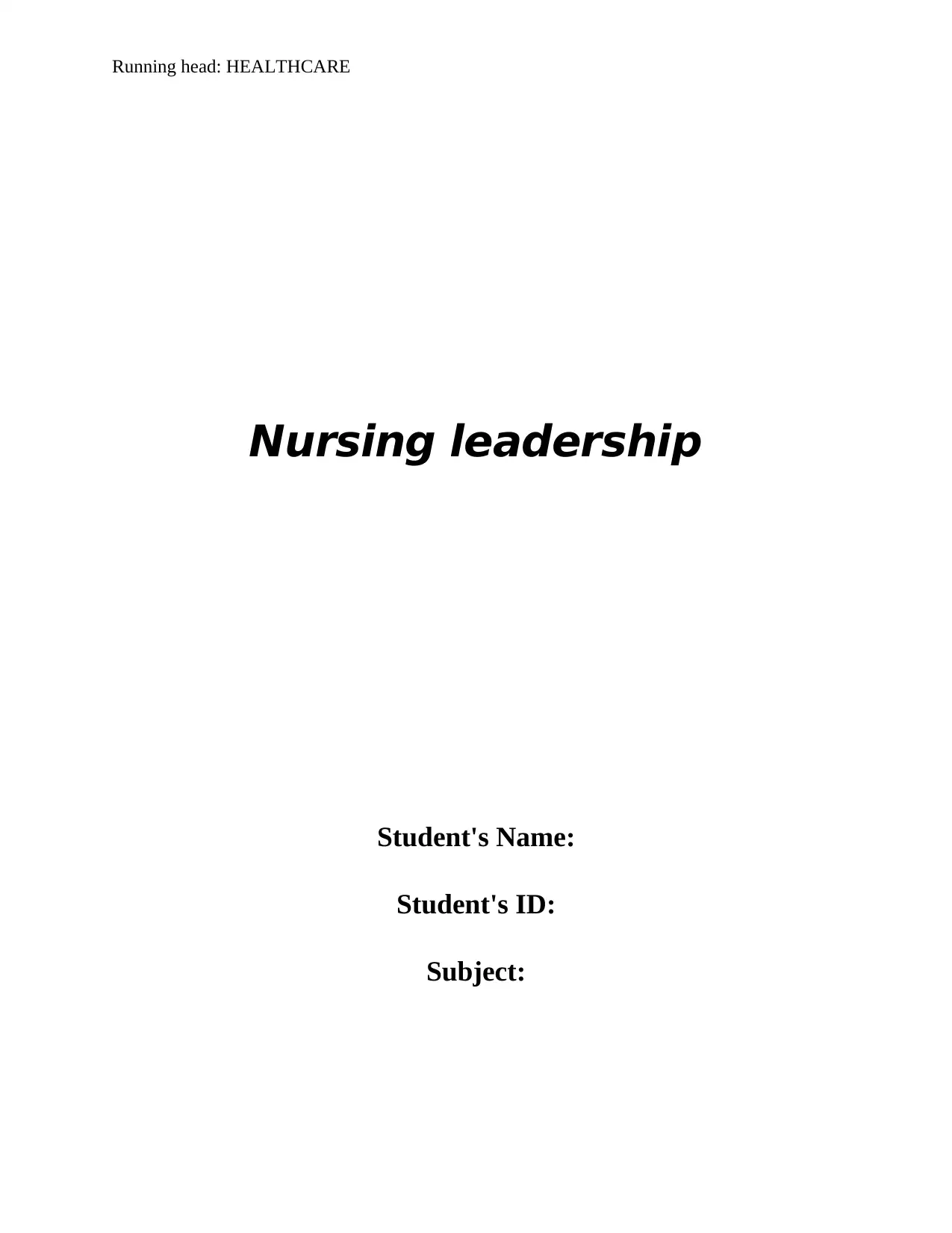
Running head: HEALTHCARE
Nursing leadership
Student's Name:
Student's ID:
Subject:
Nursing leadership
Student's Name:
Student's ID:
Subject:
Paraphrase This Document
Need a fresh take? Get an instant paraphrase of this document with our AI Paraphraser
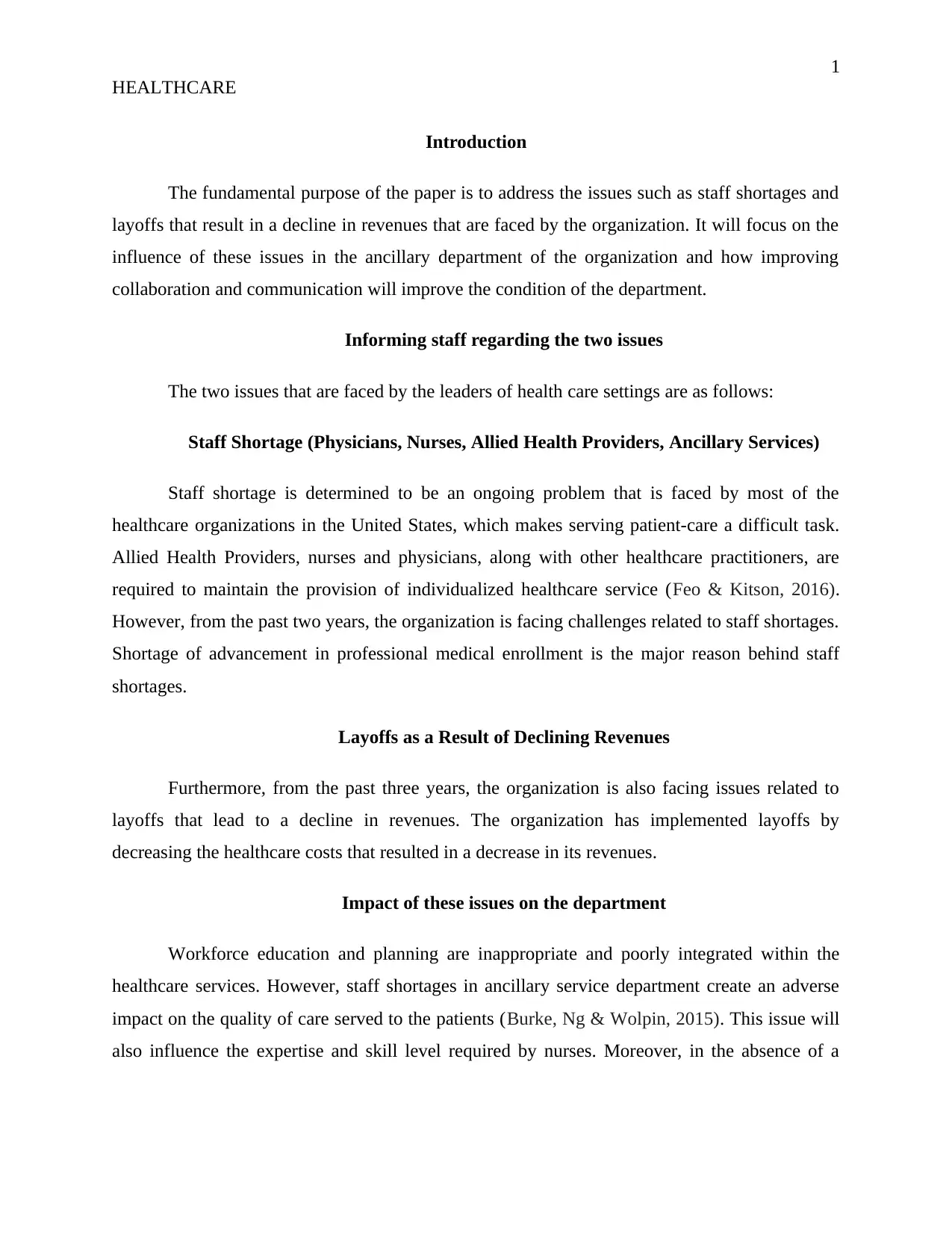
1
HEALTHCARE
Introduction
The fundamental purpose of the paper is to address the issues such as staff shortages and
layoffs that result in a decline in revenues that are faced by the organization. It will focus on the
influence of these issues in the ancillary department of the organization and how improving
collaboration and communication will improve the condition of the department.
Informing staff regarding the two issues
The two issues that are faced by the leaders of health care settings are as follows:
Staff Shortage (Physicians, Nurses, Allied Health Providers, Ancillary Services)
Staff shortage is determined to be an ongoing problem that is faced by most of the
healthcare organizations in the United States, which makes serving patient-care a difficult task.
Allied Health Providers, nurses and physicians, along with other healthcare practitioners, are
required to maintain the provision of individualized healthcare service (Feo & Kitson, 2016).
However, from the past two years, the organization is facing challenges related to staff shortages.
Shortage of advancement in professional medical enrollment is the major reason behind staff
shortages.
Layoffs as a Result of Declining Revenues
Furthermore, from the past three years, the organization is also facing issues related to
layoffs that lead to a decline in revenues. The organization has implemented layoffs by
decreasing the healthcare costs that resulted in a decrease in its revenues.
Impact of these issues on the department
Workforce education and planning are inappropriate and poorly integrated within the
healthcare services. However, staff shortages in ancillary service department create an adverse
impact on the quality of care served to the patients (Burke, Ng & Wolpin, 2015). This issue will
also influence the expertise and skill level required by nurses. Moreover, in the absence of a
HEALTHCARE
Introduction
The fundamental purpose of the paper is to address the issues such as staff shortages and
layoffs that result in a decline in revenues that are faced by the organization. It will focus on the
influence of these issues in the ancillary department of the organization and how improving
collaboration and communication will improve the condition of the department.
Informing staff regarding the two issues
The two issues that are faced by the leaders of health care settings are as follows:
Staff Shortage (Physicians, Nurses, Allied Health Providers, Ancillary Services)
Staff shortage is determined to be an ongoing problem that is faced by most of the
healthcare organizations in the United States, which makes serving patient-care a difficult task.
Allied Health Providers, nurses and physicians, along with other healthcare practitioners, are
required to maintain the provision of individualized healthcare service (Feo & Kitson, 2016).
However, from the past two years, the organization is facing challenges related to staff shortages.
Shortage of advancement in professional medical enrollment is the major reason behind staff
shortages.
Layoffs as a Result of Declining Revenues
Furthermore, from the past three years, the organization is also facing issues related to
layoffs that lead to a decline in revenues. The organization has implemented layoffs by
decreasing the healthcare costs that resulted in a decrease in its revenues.
Impact of these issues on the department
Workforce education and planning are inappropriate and poorly integrated within the
healthcare services. However, staff shortages in ancillary service department create an adverse
impact on the quality of care served to the patients (Burke, Ng & Wolpin, 2015). This issue will
also influence the expertise and skill level required by nurses. Moreover, in the absence of a
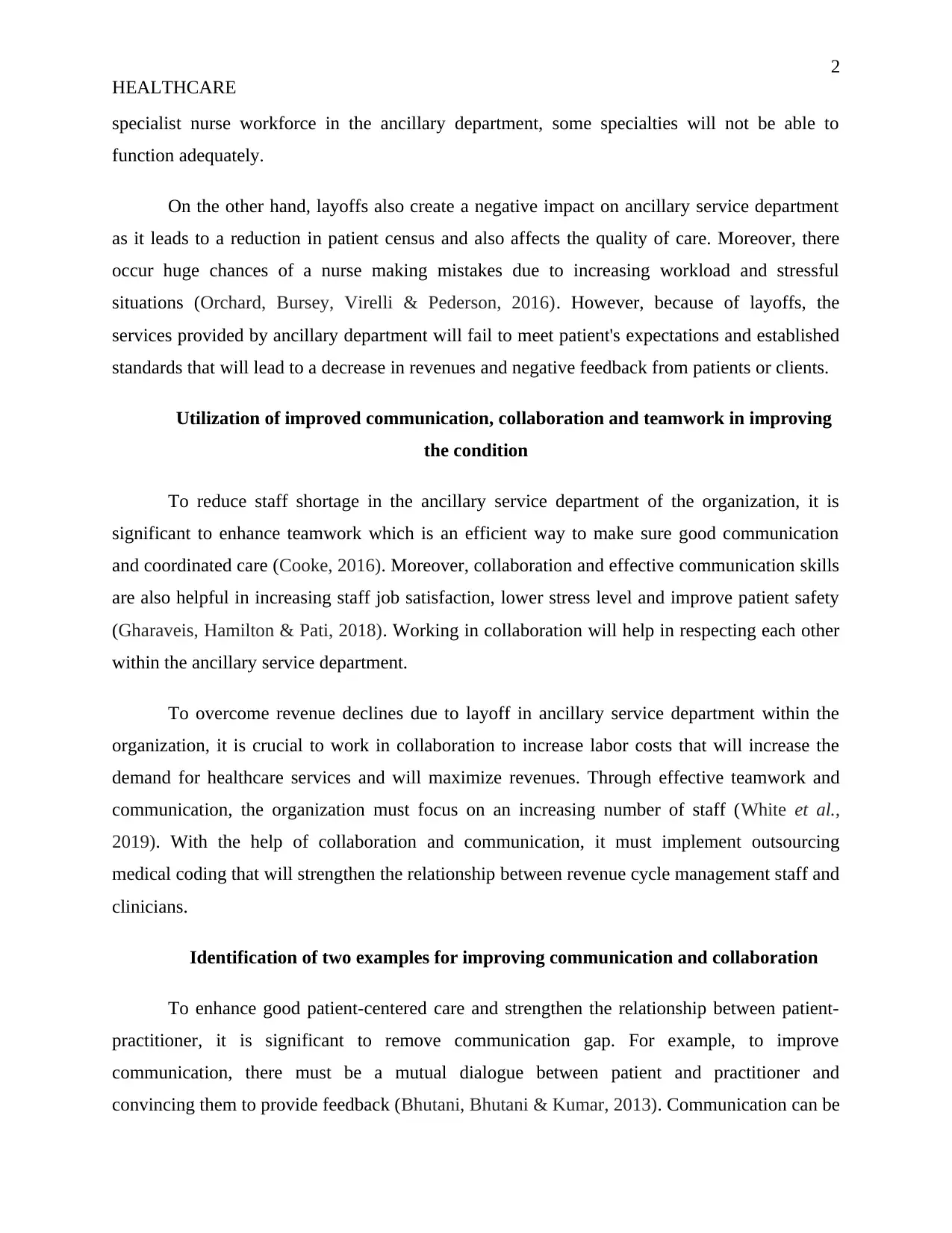
2
HEALTHCARE
specialist nurse workforce in the ancillary department, some specialties will not be able to
function adequately.
On the other hand, layoffs also create a negative impact on ancillary service department
as it leads to a reduction in patient census and also affects the quality of care. Moreover, there
occur huge chances of a nurse making mistakes due to increasing workload and stressful
situations (Orchard, Bursey, Virelli & Pederson, 2016). However, because of layoffs, the
services provided by ancillary department will fail to meet patient's expectations and established
standards that will lead to a decrease in revenues and negative feedback from patients or clients.
Utilization of improved communication, collaboration and teamwork in improving
the condition
To reduce staff shortage in the ancillary service department of the organization, it is
significant to enhance teamwork which is an efficient way to make sure good communication
and coordinated care (Cooke, 2016). Moreover, collaboration and effective communication skills
are also helpful in increasing staff job satisfaction, lower stress level and improve patient safety
(Gharaveis, Hamilton & Pati, 2018). Working in collaboration will help in respecting each other
within the ancillary service department.
To overcome revenue declines due to layoff in ancillary service department within the
organization, it is crucial to work in collaboration to increase labor costs that will increase the
demand for healthcare services and will maximize revenues. Through effective teamwork and
communication, the organization must focus on an increasing number of staff (White et al.,
2019). With the help of collaboration and communication, it must implement outsourcing
medical coding that will strengthen the relationship between revenue cycle management staff and
clinicians.
Identification of two examples for improving communication and collaboration
To enhance good patient-centered care and strengthen the relationship between patient-
practitioner, it is significant to remove communication gap. For example, to improve
communication, there must be a mutual dialogue between patient and practitioner and
convincing them to provide feedback (Bhutani, Bhutani & Kumar, 2013). Communication can be
HEALTHCARE
specialist nurse workforce in the ancillary department, some specialties will not be able to
function adequately.
On the other hand, layoffs also create a negative impact on ancillary service department
as it leads to a reduction in patient census and also affects the quality of care. Moreover, there
occur huge chances of a nurse making mistakes due to increasing workload and stressful
situations (Orchard, Bursey, Virelli & Pederson, 2016). However, because of layoffs, the
services provided by ancillary department will fail to meet patient's expectations and established
standards that will lead to a decrease in revenues and negative feedback from patients or clients.
Utilization of improved communication, collaboration and teamwork in improving
the condition
To reduce staff shortage in the ancillary service department of the organization, it is
significant to enhance teamwork which is an efficient way to make sure good communication
and coordinated care (Cooke, 2016). Moreover, collaboration and effective communication skills
are also helpful in increasing staff job satisfaction, lower stress level and improve patient safety
(Gharaveis, Hamilton & Pati, 2018). Working in collaboration will help in respecting each other
within the ancillary service department.
To overcome revenue declines due to layoff in ancillary service department within the
organization, it is crucial to work in collaboration to increase labor costs that will increase the
demand for healthcare services and will maximize revenues. Through effective teamwork and
communication, the organization must focus on an increasing number of staff (White et al.,
2019). With the help of collaboration and communication, it must implement outsourcing
medical coding that will strengthen the relationship between revenue cycle management staff and
clinicians.
Identification of two examples for improving communication and collaboration
To enhance good patient-centered care and strengthen the relationship between patient-
practitioner, it is significant to remove communication gap. For example, to improve
communication, there must be a mutual dialogue between patient and practitioner and
convincing them to provide feedback (Bhutani, Bhutani & Kumar, 2013). Communication can be
⊘ This is a preview!⊘
Do you want full access?
Subscribe today to unlock all pages.

Trusted by 1+ million students worldwide
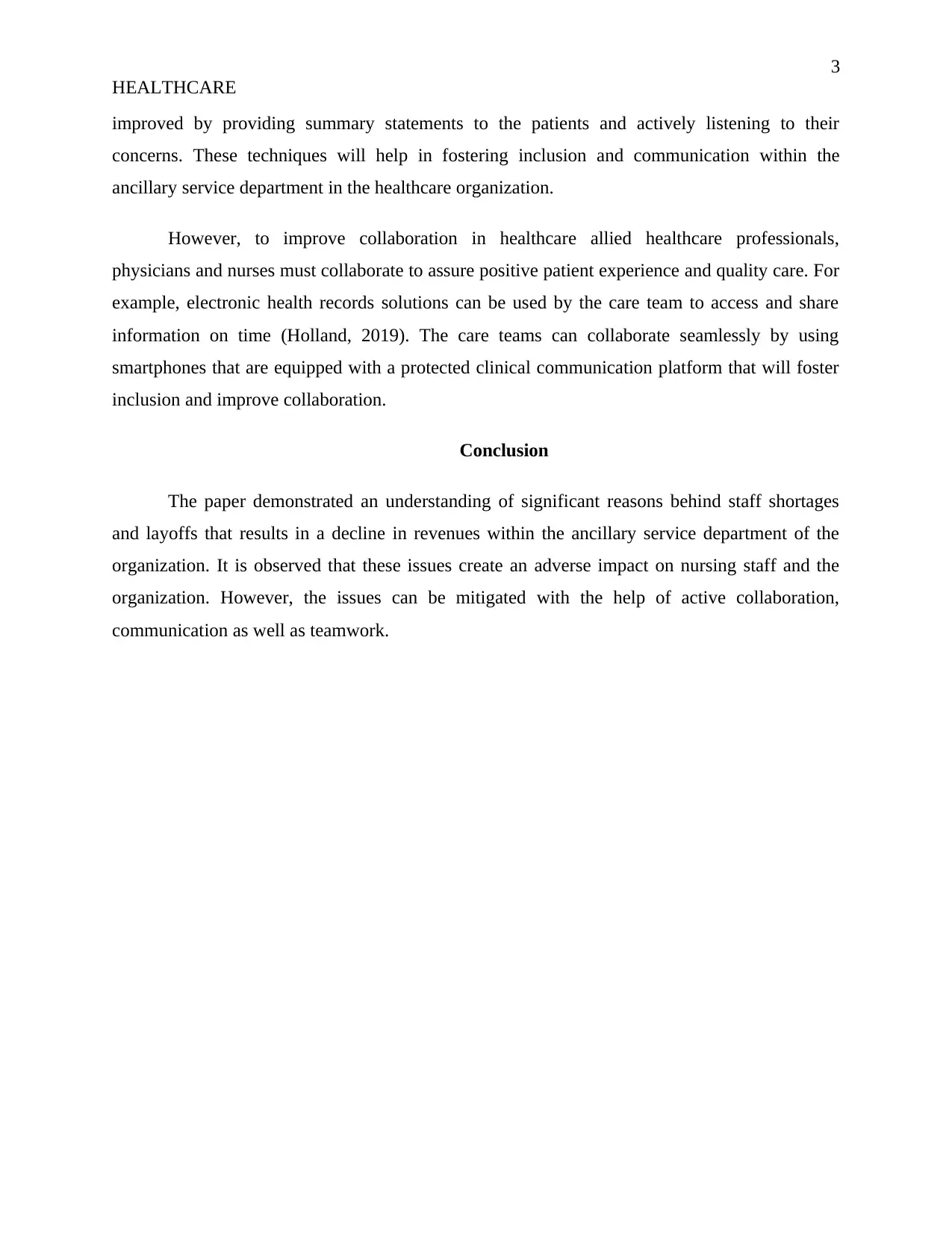
3
HEALTHCARE
improved by providing summary statements to the patients and actively listening to their
concerns. These techniques will help in fostering inclusion and communication within the
ancillary service department in the healthcare organization.
However, to improve collaboration in healthcare allied healthcare professionals,
physicians and nurses must collaborate to assure positive patient experience and quality care. For
example, electronic health records solutions can be used by the care team to access and share
information on time (Holland, 2019). The care teams can collaborate seamlessly by using
smartphones that are equipped with a protected clinical communication platform that will foster
inclusion and improve collaboration.
Conclusion
The paper demonstrated an understanding of significant reasons behind staff shortages
and layoffs that results in a decline in revenues within the ancillary service department of the
organization. It is observed that these issues create an adverse impact on nursing staff and the
organization. However, the issues can be mitigated with the help of active collaboration,
communication as well as teamwork.
HEALTHCARE
improved by providing summary statements to the patients and actively listening to their
concerns. These techniques will help in fostering inclusion and communication within the
ancillary service department in the healthcare organization.
However, to improve collaboration in healthcare allied healthcare professionals,
physicians and nurses must collaborate to assure positive patient experience and quality care. For
example, electronic health records solutions can be used by the care team to access and share
information on time (Holland, 2019). The care teams can collaborate seamlessly by using
smartphones that are equipped with a protected clinical communication platform that will foster
inclusion and improve collaboration.
Conclusion
The paper demonstrated an understanding of significant reasons behind staff shortages
and layoffs that results in a decline in revenues within the ancillary service department of the
organization. It is observed that these issues create an adverse impact on nursing staff and the
organization. However, the issues can be mitigated with the help of active collaboration,
communication as well as teamwork.
Paraphrase This Document
Need a fresh take? Get an instant paraphrase of this document with our AI Paraphraser
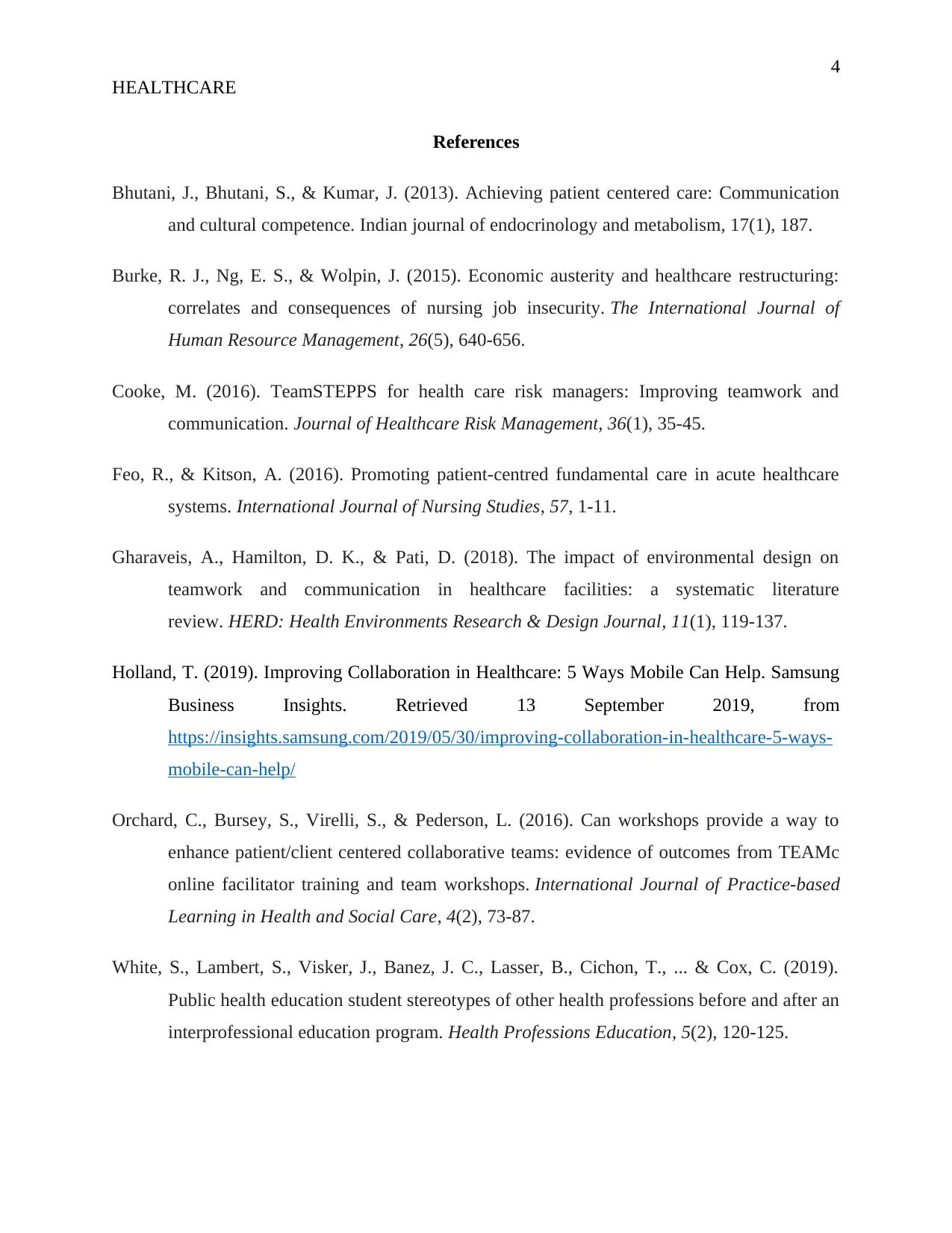
4
HEALTHCARE
References
Bhutani, J., Bhutani, S., & Kumar, J. (2013). Achieving patient centered care: Communication
and cultural competence. Indian journal of endocrinology and metabolism, 17(1), 187.
Burke, R. J., Ng, E. S., & Wolpin, J. (2015). Economic austerity and healthcare restructuring:
correlates and consequences of nursing job insecurity. The International Journal of
Human Resource Management, 26(5), 640-656.
Cooke, M. (2016). TeamSTEPPS for health care risk managers: Improving teamwork and
communication. Journal of Healthcare Risk Management, 36(1), 35-45.
Feo, R., & Kitson, A. (2016). Promoting patient-centred fundamental care in acute healthcare
systems. International Journal of Nursing Studies, 57, 1-11.
Gharaveis, A., Hamilton, D. K., & Pati, D. (2018). The impact of environmental design on
teamwork and communication in healthcare facilities: a systematic literature
review. HERD: Health Environments Research & Design Journal, 11(1), 119-137.
Holland, T. (2019). Improving Collaboration in Healthcare: 5 Ways Mobile Can Help. Samsung
Business Insights. Retrieved 13 September 2019, from
https://insights.samsung.com/2019/05/30/improving-collaboration-in-healthcare-5-ways-
mobile-can-help/
Orchard, C., Bursey, S., Virelli, S., & Pederson, L. (2016). Can workshops provide a way to
enhance patient/client centered collaborative teams: evidence of outcomes from TEAMc
online facilitator training and team workshops. International Journal of Practice-based
Learning in Health and Social Care, 4(2), 73-87.
White, S., Lambert, S., Visker, J., Banez, J. C., Lasser, B., Cichon, T., ... & Cox, C. (2019).
Public health education student stereotypes of other health professions before and after an
interprofessional education program. Health Professions Education, 5(2), 120-125.
HEALTHCARE
References
Bhutani, J., Bhutani, S., & Kumar, J. (2013). Achieving patient centered care: Communication
and cultural competence. Indian journal of endocrinology and metabolism, 17(1), 187.
Burke, R. J., Ng, E. S., & Wolpin, J. (2015). Economic austerity and healthcare restructuring:
correlates and consequences of nursing job insecurity. The International Journal of
Human Resource Management, 26(5), 640-656.
Cooke, M. (2016). TeamSTEPPS for health care risk managers: Improving teamwork and
communication. Journal of Healthcare Risk Management, 36(1), 35-45.
Feo, R., & Kitson, A. (2016). Promoting patient-centred fundamental care in acute healthcare
systems. International Journal of Nursing Studies, 57, 1-11.
Gharaveis, A., Hamilton, D. K., & Pati, D. (2018). The impact of environmental design on
teamwork and communication in healthcare facilities: a systematic literature
review. HERD: Health Environments Research & Design Journal, 11(1), 119-137.
Holland, T. (2019). Improving Collaboration in Healthcare: 5 Ways Mobile Can Help. Samsung
Business Insights. Retrieved 13 September 2019, from
https://insights.samsung.com/2019/05/30/improving-collaboration-in-healthcare-5-ways-
mobile-can-help/
Orchard, C., Bursey, S., Virelli, S., & Pederson, L. (2016). Can workshops provide a way to
enhance patient/client centered collaborative teams: evidence of outcomes from TEAMc
online facilitator training and team workshops. International Journal of Practice-based
Learning in Health and Social Care, 4(2), 73-87.
White, S., Lambert, S., Visker, J., Banez, J. C., Lasser, B., Cichon, T., ... & Cox, C. (2019).
Public health education student stereotypes of other health professions before and after an
interprofessional education program. Health Professions Education, 5(2), 120-125.
1 out of 5
Related Documents
Your All-in-One AI-Powered Toolkit for Academic Success.
+13062052269
info@desklib.com
Available 24*7 on WhatsApp / Email
![[object Object]](/_next/static/media/star-bottom.7253800d.svg)
Unlock your academic potential
Copyright © 2020–2025 A2Z Services. All Rights Reserved. Developed and managed by ZUCOL.





